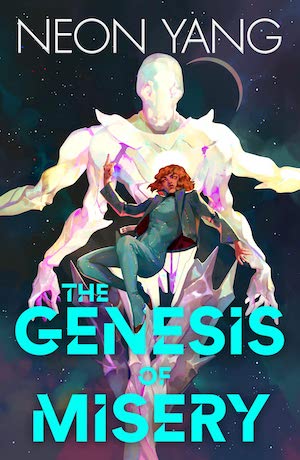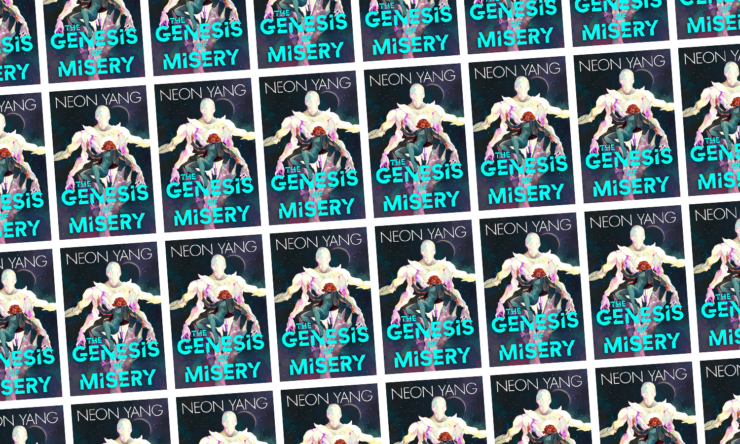Misery Nomaki (she/they) has a few different problems all happening at once. Problem one: she’s sick. Void madness, just like her mother, resulting in hallucinations and an inability to distinguish reality from fiction. Problem two: her visions are getting sassy. One of her hallucinations has decided zie’s an angel and goes by the name Ruin. Fair enough. Unfortunately, Misery’s solution to hiding their madness has led to problem three: claiming to be the Ninth Messiah that will unite the throne and church under one banner, which has resulted in her being forcibly taken to the capital where the truth of her sickness will be revealed. What happens next is not something even Misery could’ve predicted: everyone believes her.
Thus starts one of my favorite space operas of the year: Neon Yang’s electric, delectable, sometimes dark but always thrilling novel debut, The Genesis of Misery.
Best known for their Tensorate Series, Yang moves from epic fantasy into science fantasy with The Genesis of Misery, a retelling of Joan of Arc that sings with flavors of Evangelion and A Memory Called Empire. The Genesis of Misery is chock full of narrative tricks, changing what could be a fairly straightforward origin story into a puzzle box for readers to tinker with, turning the story over and over in their hands, trying to find the truth amidst the layers. A clever framing device bookends Misery’s story, giving readers an idea that not is all as it seems, going so far as to include myths and stories in-universe in between narrative action, on top of another’s perspective peppering the plot. Yang certainly had their hands full while working on this; at times, you wonder if the book can support such a structure. And yet, they pull it off beautifully, crafting a story that gives the readers multiple lenses through which to see it and remind us that no story hues toward a singular truth, that there will always be, and should always be, many perspectives on what we call history.
Buy the Book


The Genesis of Misery
All of the various narrative tricks reach the heights they do because of Yang’s compelling, nuanced characters and the intricate, dangerous, and beautiful world they set them in. Every character is searching for some form of truth, some way of surviving a world ultimately set against them, and in that search there are compromises, treachery, corruption, righteousness, and more grey moral choices than you can shake a stick at. Misery alone is a bundle of contradictions and desperation, lying through their teeth to get through each day, only to start believing her own lies, even as they increasingly make life harder for her and those around her. Determined and scrappy, as they grow in power, they only fall deeper into the hole she’s digging for herself. Throughout the book though, Neon delicately pokes holes in Misery’s bullshit, and all the narrative pathways give readers just enough information to signal things are askew, even as Misery keeps believing otherwise.
Yang beautifully builds this character so hungry to live on their own terms after a lifetime of pain and abuse, so eager to find joy and love even knowing she must bite the hand that feeds before it hurts her again. With Ruin whispering in one ear and the church whispering in the other, Misery’s guiding compass has to be herself. Over the course of the novel, we watch them slowly open up to others, find real relationships amidst the mistrust and lies, and become eager to prove that yes, they’re a liar, but they’re also a decent person if given the chance. I’m in awe at what Yang accomplishes with Misery Nomaki. And that’s just the first half of the book! What happens in the second half in which (no spoilers) Misery begins to truly believe their own hype, to put it mildly, is straight up chilling. Yang paints a portrayal of power and faith intertwining with personal vendettas and agenda of empire to create something truly awe-inspiring and terrifying.
And all of this is without even getting into the beauty and complexity of Yang’s worldbuilding, a facet of their writing that made the Tensorate series so engaging and is on full display here. Stories survivors meeting angels in the stars, holystone that grants different abilities and powers depending on your connection with it, massive mechas granted by previously mentioned angels that can only be piloted by teams of soldiers all able to work as one, not to mention the Lady Lee Alodia Lightning, sister of the Emperor or Ruin, that mischievous and dark vision that certainly has an agenda of zir own. Yang’s mighty imagination is here and alive in this book as empire and church fight for domination within themselves, let alone against the rebels who reject both, living out in the stars. And I personally loved the use of neopronouns for many characters, as well as a character’s pronouns simply accompanying their first time on the page, signaling an ease of presence and way of culture in-book, too.
The Genesis of Misery is a thrilling, inventive, enthralling book, one that had me eager to unravel its mysteries, understand its nuances, and trust in Yang’s vision of this beautiful and devastating story—which as the title implies, is only the beginning of a continuing epic. Misery Nomaki is one of my new favorite characters in science fiction and seeing how they start this novel and where they end by the end was a ride I’m not going to forget. As a Joan of Arc analog, and knowing there’s more to come, I anticipate faith and flames in future books, and I can’t wait to see how Misery weathers both.
The Genesis of Misery is published by Tor Books.
Martin Cahill is a writer living in Queens who works as the Marketing and Publicity Manager for Erewhon Books. He has fiction work forthcoming in 2021 at Serial Box, as well as Beneath Ceaseless Skies and Fireside Fiction. Martin has also written book reviews and essays for Book Riot, Strange Horizons, and the Barnes and Noble SF&F Blog. Follow him online at @mcflycahill90 and his new Substack newsletter, Weathervane, for thoughts on books, gaming, and other wonderfully nerdy whatnots.










